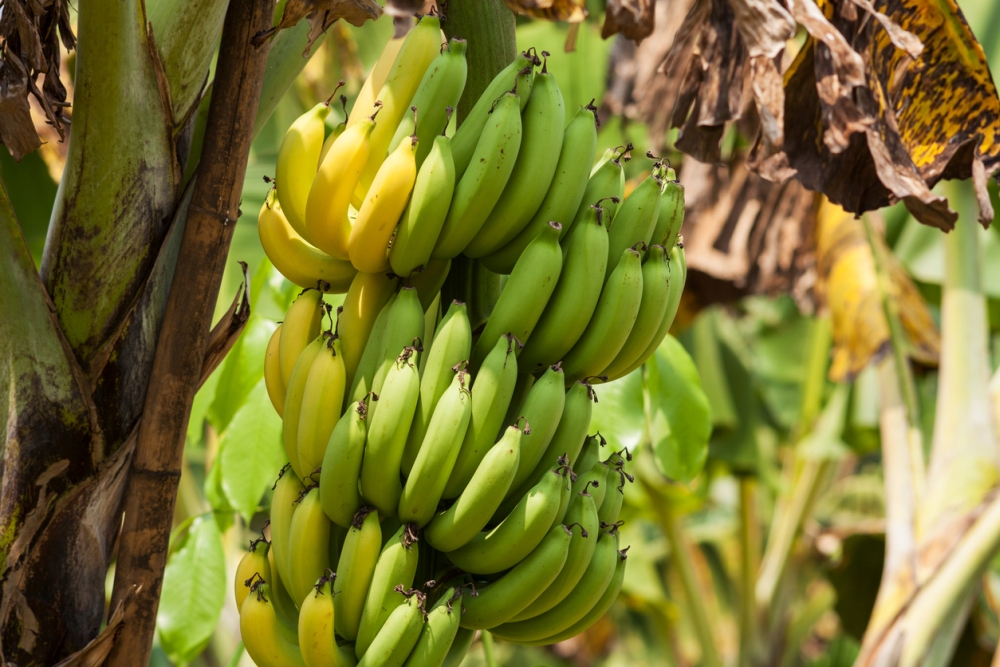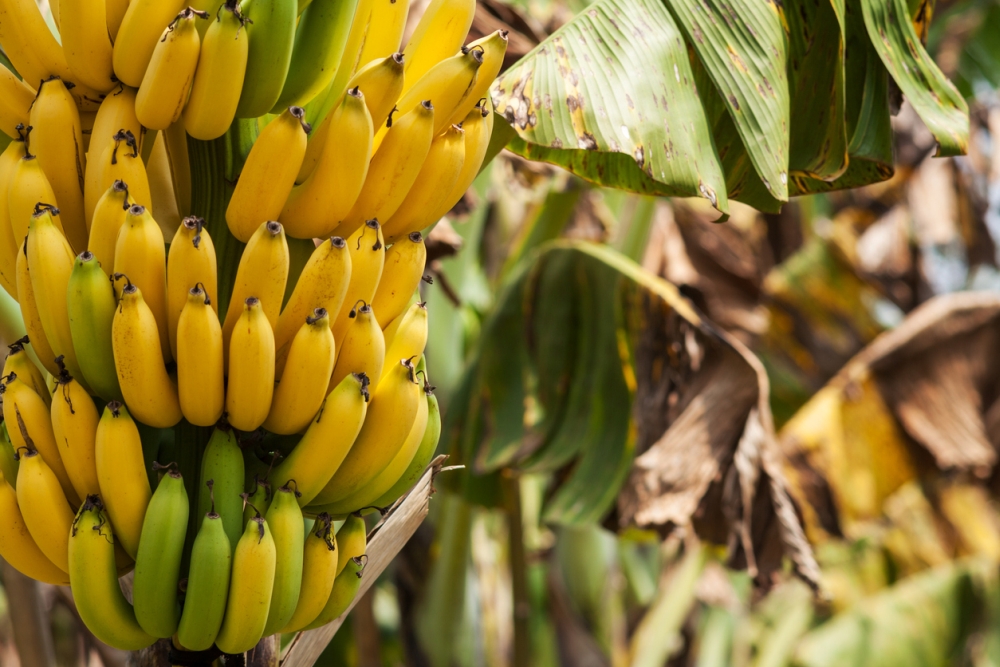Banana Growing Problems – Fixing Common Banana Tree Issues
Banana growing problems are so numerous, only a few dare to take on that challenging task. No matter how much gardening experience you have, the banana tree would keep challenging you with health issues. Some of these problems are easier to fix than others. But when the tree stops fruiting altogether or suddenly dies after fruiting, you might start to question your life decisions. But we’re here to help. This article deals with some of the most common banana growing problems and how to fix them.
Banana Growing Problems: Tree Not Fruiting
Your banana tree is growing well. The flowers opened and you’re getting excited thinking about all the hands of banana you’ll be harvesting very soon. Only, when the fruits finally emerge, they’re not edible at all. These are not the bananas you buy at the grocery store. Meanwhile, the tree looks satisfied with a job well done. So what happened?
Lack of fruiting is one of the most frustrating banana growing problems and the causes vary. For one, you might have planted a variety that doesn’t fruit. Another reason might be the tree is too young to fruit. Both the soil and temperature have a great impact on whether the banana tree will grow or not. Also pruning the wrong stem might damage the tree and prevent it from bearing fruits.
How to Fix it
To fix this one of the top banana growing problems, you’ll need to go through a list of possible causes that keep the banana tree from fruiting and fix them one by one. Here are some of the reasons and what you can do to fix them.
- Make sure your banana tree is not one of the varieties pink velvet banana, dwarf banana, or red banana. These varieties are mainly grown for their ornamental values as they produce magnificent flowers. Their fruits are not edible.
- Banana trees are heavy feeders. They grow well in rich soil and require plenty of plant food supplements. You should apply compost, organic materials, and aged manure regularly during the growing season to keep the tree healthy and encourage fruiting.
- When pruning the banana tree in the fall, make sure to cut only the old stems. New stems will fruit next summer.
- The soil pH also plays a part in the tree’s ability to fruit or not. Banana trees prefer soil pH between 5.5 to 7.0 which is either neutral or slightly acidic.
- The tree also basks in warm temperatures in the lower 80s Fahrenheit. If the temperature drops to the low 60s, that could be why the tree is not producing any fruits.
Banana Growing Problems: Tree Dies After Fruiting
As a perennial herb, you’d expect your banana tree to stay around for a few years and hopefully fill your pantry with many banana hands. So when your young banana tree dies after fruiting, you might start to suspect foul play. But there’s no foul play involved here. This is not your fault either. It’s just how banana trees work.
Banana tree death after fruiting is a natural process and is not one of the banana growing problems. It’s only a problem if you don’t understand the banana tree life cycle and might decide to uproot the dead stump. One word, Don’t!
How to Fix it
Although for all appearances the banana tree that only a few weeks ago was alive and well is dead now, that’s not the end of it. As the stump dies out, new suckers emerge from it and start to grow and develop into full trees.
You can cut out those suckers or pups and start new trees elsewhere. If you don’t want to go through the trouble, the suckers will grow where they are and soon you’ll have a few banana trees replacing the dead parent. It usually takes the baby trees 9 months to reach maturity and start producing fruits. The new trees will be identical to the parent.
Black Spots On Banana
Bananas have notoriously small ripening windows. One day, the banana is green and inedible. But maybe the next day, it’s suddenly ripe and practically begging you to eat it. And before you know it, black spots appear on the skin and spread all over the ripe bananas. Is that reason to be concerned? Not at all. That’s just the fruit at the peak of ripeness.
But when the black spots appear on the banana tree itself, that’s a different issue. In fact, this is one of the banana growing problems that you need to address as soon as you discover them. Black spots are caused by Black Sigatoka, a fungus that attacks banana trees. They usually appear on the leaves of mature trees and soon spread to the rest of the leaves. As a result, the tree’s growth slows down and it might not flower or fruit.
How to Fix it
To prevent this potentially lethal disease, you’ll need to take a few steps to ensure the banana tree is enjoying ideal growing conditions.
- Make sure the humidity levels around the banana tree are not high and that the air circulation is optimal. This prevents the spores of the fungus from growing.
- Apply slow-release organic compost and balanced fertilizer to encourage growth and help the tree fight diseases.
- Remove any infected leaves to keep the fungus from spreading and taking over the tree’s canopy.
- Apply a fungicide if the infection gets out of hand.
Bananas With Cracked Skin
If black spots on banana fruits happen when the fruits are ripening, cracked skin issues happen to the fruits while they are on the tree. In other words, while you’re waiting patiently to harvest your bananas, suddenly you notice their skin cracking open everywhere. And while fruits with black spots are nothing to worry about, you have every reason to be concerned when the skin of the unripe fruits splits open on the tree.
This is one of the banana growing problems that you need to work quickly to fix before you lose your whole banana yield for that year. And the most common culprit is often high humidity. If humidity reaches 90 percent around the tree during fruiting, the skin of the bananas might split open. Another reason could be high temperatures. We said that these perennial herbs bask in high temperatures around 80 degrees Fahrenheit. But if the temperature rises above the 90s Fahrenheit and stays there, the fruits will burst open in protest.
How to Fix it
To fix this problem, you need to be vigilant and keep your eye on the weather forecast. If you expect a heatwave, you might go ahead and harvest your bananas before the excessive heat damages them. Here are other things to do.
- Improve the airflow around the banana tree especially during the fruiting season. Humidity might rise after rainfall so improved circulation would keep humidity levels down.
- Don’t keep your bananas on the tree to ripen. This usually damages the fruits and diminishes the yield’s taste and flavor.
- The best time to harvest the banana fruits is when the skin is green. If the skin turns yellow-green, they’re already ripening and should be gathered immediately.
- Store the banana fruits at a temperature around 69 degrees Fahrenheit until they’re ripe. If exposed to higher temperatures the banana will ripen quickly which causes the skin to crack.
Banana Growing Problems: Fusarium Wilt
Nothing breaks a gardener’s heart like watching their banana tree wilting and dying in front of their eyes. And as far as banana growing problems go, fusarium wilt is one of the most common health issues that you’ll encounter. In fact, this is the number one killer of banana trees worldwide.
Commonly known as Panama disease, fusarium wilt is a fungal disease that starts from the roots of the tree. That’s the entry point for the fungus spores that proceed to make their way up the trunk of the tree. Along the way, the spores multiply and take over the passageways that the tree uses to transport the moisture and nutrients to the leaves. Eventually, the tree stops growing and the new leaves turn yellow then die out slowly. As for the lower and more mature leaves, they wilt and turn yellow as well then droop and fall to the ground.
How to Fix it
The reason fusarium wilt is such a lethal disease for banana trees is that there’s no cure for it. Once the fungus infects a tree, there’s no stopping it and the tree is as good as gone. Making it more difficult, the spores of the fungus will latch on to anything from shoes to insects and gardening tools. So it’s not really easy to control the spread of the fungus and protect your banana trees against it. Still, all is not lost, and you can still take these steps to contain the damage of fusarium wilt.
- Uproot the infected banana trees and dispose of them safely.
- Plant disease-resistant cultivars that are at low risk of getting infected with fusarium wilt.
- In the early stages of the fungal infection, applying a fungicide might help slow its progress.
- Keep your garden clean and remove weeds, debris, and pests.
- Only use sterilized gardening tools.
- If your banana trees get infected, plant the new trees in a different area since the spores can live in the soil for years.
Banana Growing Problems: Overwintering A Banana Tree
Banana trees are tropical plants. They thrive in high temperatures and bask in the warm sun. So when the winter sets in with its gray skies and frigid temperature, the banana tree will struggle for sure. And even though the tree is mostly dormant during the winter, it is still at risk of freezing over when the temperature drops below 20 degrees Fahrenheit.
If your winters are particularly harsh and you don’t expect your banana tree to survive, then just let it die out and plant a new tree the next spring. As annuals, banana trees are fast growers and will fruit in the same year you plant them. But that’s usually the last resort. There are still ways you can save your banana tree and ensure it comes back to life by the next spring.
How to Fix it
It’s not always easy to keep the banana tree alive through a very cold winter. And sometimes the tree that comes out on the other side is not as vigorous or high-yielding as a new tree. But for what’s it’s worth, here are a few ways you can keep your perennial herb growing year after year even if the winter is cold.
- Plant your banana tree in a container. That makes it easier to move it indoors when the weather turns and the temperature drops. Red banana is ideal for container growing since it has a compact size. Keep the potted tree near a window that gets plenty of light and water regularly.
- Prune the tree heavily in the fall leaving only a few new stems. Remove all old stems and leaves. Then cut the tree leaving about six inches of the trunk in the ground.
- Put the cut tree in a container filled with soil and store it in a dark room. Water the soil a few times during the winter. In the spring, you can plant it in the garden. However, the tree’s growth will be slow and it might not fruit at all.
- As for the stump you left out in the garden, cover it with a thick layer of mulch to protect it against the cold. In the spring, suckers will grow out of the stump and you can plant them or let them grow into banana trees.

